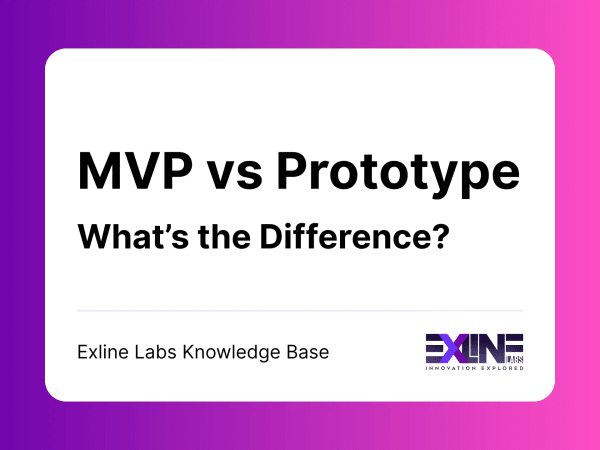What Is an MVP? A Guide for Startups

Before you invest months of time and thousands of pounds building your full product, ask yourself one thing: “Do people actually want this?” The Minimum Viable Product (MVP) is how you find out, without wasting your entire budget.
Date Published
06 Nov 2025
Date Updated
20 Nov 2025
Written By
Exline Labs Team
Reading Time
3 min read
Service Type
MVP DevelopmentIntroduction
Before you invest months of time and thousands of pounds building your full product, ask yourself one thing:
“Do people actually want this?”
The Minimum Viable Product (MVP) is how you find out, without wasting your entire budget.
In this guide, you’ll learn:
- What an MVP is (and what it’s not)
- Why startups need one, and how to build an MVP
- Key benefits and examples
- How MVPs fit into a lean product strategy
What Is an MVP (Minimum Viable Product)?
An MVP is a simplified version of your product with just enough features to:
- Deliver value to early users
- Validate your idea with real feedback
- Launch quickly and learn faster
It’s not your final product. It’s your first proof of concept. A lean, fast approach that highlights the MVP vs Prototype difference: real validation versus just an idea.
Key Characteristics of an MVP
- Solves one core problem well
- Built quickly with limited features
- Delivers real value to real users
- Collects actionable user feedback
- Designed to validate assumptions
Why Startups Build MVPs
| Benefit | Description |
| Validate the idea early | Prove there’s real demand before scaling |
| Save time and money | Avoid building features no one uses |
| Attract investors | Show traction with a live product |
| Test assumptions | Learn what users actually want |
| Launch faster | Enter the market in weeks, not months |
60% of startups fail because they build something no one wants. An MVP protects you from this.
Common MVP Formats
| MVP Type | Use Case |
| Landing Page | Pre-launch validation with signups or interest |
| No-code App | Built with tools like Webflow, Bubble, or Glide |
| Clickable Prototype | UX flows shown in tools like Figma or Marvel |
| Coded MVP | Custom-built with core functionality only |
| Concierge MVP | Manually deliver the service behind the scenes |
MVP vs Full Product: What's the Difference?
| Feature | MVP | Full Product |
| Scope | Core only | Full functionality |
| Time to Build | 2–6 weeks | 3–9 months |
| Cost | Low | High |
| Goal | Learn fast | Scale and monetize |
When Should You Build an MVP?
You're ready for an MVP if:
- You’ve identified a clear pain point
- You can define a single target user
- You want to test a solution before raising funding
- You’re short on time, budget, or dev resources
Have any Questions?
What does MVP stand for in startups?
MVP stands for Minimum Viable Product — a lean version of your product that solves one problem and collects user feedback.
Why is building an MVP important?
It saves time and money, helps validate your idea early, and reduces risk.
How long does it take to build an MVP?
Typically 2–6 weeks, depending on scope and tech stack.
Is an MVP the same as a prototype?
No — a prototype shows design or concept. An MVP is functional and usable by real customers.
Can I build an MVP without coding?
Yes — tools like Bubble, Webflow, or Glide allow no-code MVPs.
What should an MVP include?
Only the essential features needed to solve a user’s primary problem and gather feedback.
Who builds MVPs — freelancers, agencies, or internal teams?
All three. Exline Labs specializes in MVPs for startups using lean, scalable approaches.
Should I raise money before or after building an MVP?
Ideally after — investors want to see real traction or feedback.
What happens after the MVP is launched?
You gather feedback, iterate, and decide whether to pivot, scale, or rebuild.
How can Exline Labs help?
We work with startups to define, build, and validate MVPs in 2–6 weeks, with ongoing support for scaling.


